Stockholm World Water Week 2011: Megacities, Human Rights, Sanitation, Tech Tools, Energy, and Food
2,600 global experts. 100 sessions. Seven days. One issue: water.
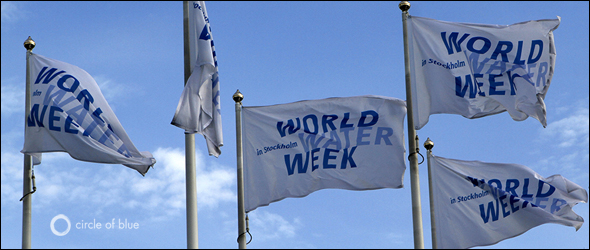
Updated
STOCKHOLM, Sweden —The largest mass migration in history, drawing billions of people from rural areas to cities, is posing a major risk on global water security and prompting planners, experts, businesses, and policy makers to design new standards for measuring water risk. But the world’s capacity to respond to age-old problems like sanitation is in doubt, as conventional estimates of safe access to water and sanitation globally might be “grossly underestimated” — several times smaller than the reality on the ground.
This striking revelation came at a panel in Stockholm last week and is perhaps the most dire warning that emerged from 100 sessions at World Water Week 2011, which brought together more than 2,600 politicians, business leaders, international organizations, scientists, and water professionals to tackle the growing challenge of securing water for the world’s booming urban areas.
Many of the problems facing megalopolises are the same topics that have been on the table for years: the one-year anniversary of the human right to water, food, energy, as well as the new tools, technology, and innovation — or lack thereof — for assessing water-related risks to governments, businesses, and individuals.
— Anders Berntell,
Stockholm Water Institute
In the span of seven days during the conference, global water experts convening in Stockholm called for increased investments in water infrastructure, smarter water management, and innovation to avoid droughts, floods, pollution, and overuse from further threatening the food, energy, and water security in a rapidly urbanizing world.
“We face an unmitigated disaster. Jaipur, India is out of water. What’s going to happen to places like that?” said Paul Reiter, executive director of the International Water Association (IWA), at the closing ceremony in Stockholm this morning. “We’re adding 1 million people every week times 52 weeks times 40 years. Who’s going to respond to this challenge?”
With this kind of pressure, Reiter wonders how the world will rethink its water and sanitation systems, if governments and agencies are capable of the big decisions ahead, and if they will be the right ones.
“We still have a huge challenge to reach decision makers,” said Anders Berntell, executive director of the Stockholm Water Institute, during today’s closing ceremonies. He announced that next year’s theme will be “Water and Food.”
At this year’s event, Circle of Blue has been following these buzzwords and trends that promise to define the next era of global development:
Sanitation Numbers “Grossly Underestimated”
Many old problems — like sanitation, which could be a much bigger problem than has been publicized — still loom over most global urban centers. And, without proper planning, the results of the current urban migration could be disastrous.
“The big, big, big problem is that people cannot conceptualize that cities are growing by 800,000 people a week. It’s like a slow moving train that’s very dangerous,” Reiter said. “People are responding, but not with vigor and scale. The development community is in perpetual pilot and testing mode, but we need whole city solutions. Most of what we do now is tactical, not strategic. Even if we had more resources, I’m not sure it would make a difference.”
This means that addressing sanitation is slipping back onto the world’s agenda, according to the panel of experts.
“Sanitation becomes a budget orphan — split between health, water and education — and, as such, no ministry has total control of it,” said Betty Atuku Bigombe, Uganda’s Minister of State for Water.
About 0.9 billion people around the world don’t have access to “improved” drinking water and around 2.6 billion don’t have access to “improved” sanitation, according to the conventional standard that the United Nations uses to track progress with the Millennium Development Goals (MDGs). But these numbers are “grossly underestimated,” said Jack Moss, senior water advisor at AquaFed, a Paris-based trade association that represents more than 300 privately owned water and sanitation companies in 40 countries.
According to Moss, the estimate does not take into account the criteria to meet the human right to safe drinking water and sanitation, as stipulated by the United Nations in June 2010. Conservative estimates by AquaFed that incorporate the standard to meet the human right to water suggest that the number of people without access to safe drinking water could be between 3 billion and 4 billion. Some other estimates show that if we had a similar definition for sanitation as we do for water, the number of people without satisfactory access to sanitation could be as high as 5.5 billion.
“I’ve been concerned about many of the discussions here in this congress; that we are still talking about the MDG figures — which is one thing and hard enough to measure — and that we are not bringing ourselves up to speed to the new standards that are required,” Moss said. “We have an obligation to get the cursor in the right place.”
The Future: Megacities
Of all the challenges that influence the urban transition, none seems more fundamental than water, which intersects with everything from energy to economics, from climate to food. By 2050, the United Nations has projected that 70 percent of the world’s population will live in urban areas, up from about 50 percent today.
Urbanization is happening fastest in the world’s burgeoning megacities and metacities – the urban centers with more than 10 million residents or 20 million residents, respectively – which are mostly gaining ground in Africa, Asia, and Latin America.
“Urban water” was not only a theme of Stockholm Water Week 2011, but also for this year’s World Water Day on March 22 and the 2011 Singapore International Water Week in June.
In Stockholm this week, World Wildlife Fund (WWF) premiered a new study outlining six sprawling megalopolises around the world, where hundreds of millions of people are left without adequate access to drinking water and sanitation. The report concluded that city infrastructure cannot keep pace with massive urban growth and that water scarcity, pollution, overuse, salt-water intrusion, and climate change will be the main issues plaguing the development of the global cities of the future.
Although this urban transformation holds a major risk for global water security — as many of the world’s metropolitan centers lack the planning, infrastructure, capacity, and water resources needed to support the new tide of urban residents — it is also prompting some of the most systemic thinking and management investments to date on these issues.
“Cities provide great economies of scale and offer excellent opportunities for effective infrastructure development, for increased re-use of water and waste, and for more efficient use of water and energy”, said Anders Berntell, executive director of the Stockholm International Water Institute, at the opening session of the 2011 World Water Week.
Developed economies and megacities generate about two-thirds of the world’s gross domestic product (GDP), receive the majority of the global private investment, and consume the lion’s share of the world’s resources. In other words, megacities will determine the direction of much of the world’s assets, development models, and expertise by creating hubs for business, culture, education, technology, and innovation – the very tools needed to design solutions.
Water partnerships in Asia are becoming models for the rest of the world, particularly in Africa and Latin America, according to Paul Reiter, executive director of the International Water Association (IWA), which is holding several conferences this year on urban water management under its “Cities of the Future” program.
“Despite the enormous challenges that Asia is facing with growing demand on water supplies, I see a fantastic future there,” Reiter said during an Eye on Asia seminar in Stockholm this week. “The most innovative things are happening in Asia in regards to water.”
Singapore, for example, has recycled water providing 30 percent of total demand. The city-state has also become the showcase of choice for some of the latest advances in water technology, with annual forums like the Singapore International Water Week – a global platform for policymakers, industry leaders, water experts, and practitioners — signalling a growing global interest in the revival of urban planning, engineering, and innovation.
Water-Energy-Food-Climate Nexus
Feeding the world’s growing population while maintaining the same farming practices and dietary patterns of today might increase agricultural water use by 70 to 90 percent; a recipe for disaster that can only be averted by smarter use of the ecosystem, according to a report released by United Nations at the beginning of Stockholm World Water Week 2011.
“We need an agriculture that can feed 9 billion people [by 2050], while maintaining the water supplies and other ecosystem services that people need,” said Professor Stephen Carpenter, the 2011 Stockholm Water Prize Laureate, at the opening session of the conference on August 22. “The connections between food and water security have never been more important.”
Many high-intensity food-producing regions, including India’s Punjab, the North China Plain, and the Western United States, have water limits that are already being “reached or breached,” the U.N. report added. As energy production increases, the industry — especially biofuels, coal, oil, and shale gas – uses increasing amounts of water, at times forcing agriculture and other industrial sectors to use much less. How each nation responds to the tug-of-war demands will profoundly influence the energy prices, food production, and economic security of not only their own domestic markets, but all across the globe; and the situation is set to worsen through climate change, which is already disrupting patterns of snow and rainfall.
— Paul Reiter,
International Water Association
“People’s diets change when they become part of the urban environment, and, more often than not, these new diets require more water to produce food,” said Arjun Thapan, chair of the World Economic Forum’s Global Council for Water Security, at a seminar on August 24 in Stockholm. “Technology is a key determinant in overcoming this.”
The analysis is consistent with the conclusions of an upcoming report by the Food and Agriculture Organization of the United Nations (FAO). The report will examine, in detail, the use of water in agriculture and, if policy makers and governments do not act now, the potentially devastating problems in food security.
The warnings came on the heels of this year’s World Economic Forum in Davos in January, which tackled the water-energy-food-climate collision. The topic will also inform the agenda of the upcoming Bonn2011 Conference in November, as well as the Rio+ 20 United Nations Conference on Sustainable Development in June 2012.
“We need to bring together the agriculture sector,” said Reiter. “The cheapest source of water for cities is to buy efficiency for agriculture. But agriculture feels that it’s them versus everyone else; they feel they’re under siege and have to hold off everyone who wants to take their water.”
Technology and Innovation (Or Lack Thereof)
Another trend coming out of Stockholm this year has to do with water-related performance targets. Drought and flooding, declining water quality and increasing water prices are prompting top global companies to develop water policies, strategies, and plans that will ensure future success for the business — and many companies are just as worried about company image for that longevity.
“The magnitude of the problems we face today can’t be solved quarter to quarter; they’re 10-, 15-, 20-year challenges,” Dan Bena, PepsiCo’s vice president of sustainability, said during a panel discussion in Stockholm this week.
Aqueduct, a new global database of water-risk information that was announced on August 16 by World Resources Institute (WRI), will enable companies, investors, governments, and others to create water-risk maps of the world’s biggest river basins. The water atlas tool debuted this week in Stockholm, along with a few other water tools. In the government realm, WaterAid announced this week a new data site that will monitor global water and sanitation commitments, and the site will enable users to follow whether government budgets are being spent on these essential services.
“Water risk is becoming an increasingly critical global issue, but one that is inherently local and not yet fully considered in business and investment decisions,” said Kyung-Ah Park, managing director for the Goldman Sachs Environmental Markets Group, one of the founding partners in the Aqueduct project. “Aqueduct will work to facilitate better management of water risk and to help identify market opportunities that drive more sustainable economic development.”
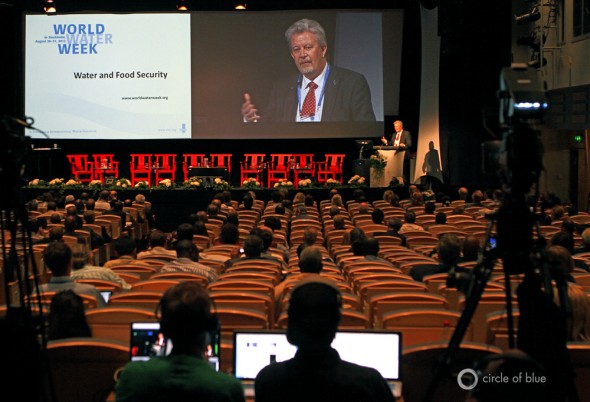
A 2010 survey by The Carbon Disclosure Project, a non-profit that provides a global database of primary corporate climate change information, showed that big global companies are becoming more aware of the water risks to their operations, with 96 percent of the respondents reporting they could identify risk in their own operations and 89 percent reporting that they have already developed specific water measures for their business. This followed an October 2010 study by the non-profit Ceres that describing the lack of water-risk disclosure in the municipal bond market.
But not only are companies waking up to water-related risks, but water-risk reporting and planning are gaining increasing attention from some investors.
“In terms of investing, it all depends on the management. One company will be able to manage through the risks and the other will not,” said Marc Robert, CEO of Water Asset Management in the U.S., while he attended World Water Week in Stockholm. “For us, we will determine exactly how we could make or lose money from a company, depending on how they manage their water-related risk.”
Yet, David Wilcox, an expert in social enterprise and founder of ReachScale, said that most of the business world lacks the innovation and sensitivity around the depth of the water problem.
“This is my 57th conference since last January, and this is the conference which has the least use of the word ‘innovation,'” he said. “Pepsi just told us about their 10- and 20-year plans. This industry has the longest investment time horizon — probably one of the four or five longest in the world — yet most of the industry doesn’t have the sense of reinvention . . . It takes big organizations a few years, once they recognize the problem, and they begin to invest in the problem before they get to the point where they can visualize where they’re going. It doesn’t seem like most of the players in water and sanitation have even started that process.”
Reporting by Circle of Blue’s J. Carl Ganter from Stockholm and Nadya Ivanova from Chicago. Additional research by Kelly Shea.
This post has been revised to reflect the following update:
Correction: August 29, 2011
An earlier version of this article misstated the United Nations’ and AquaFed’s estimates of the number of people without access to “improved” drinking water and sanitation. According to the U.N., about 0.9 billion people around the world lack access to safe drinking water and around 2.6 billion don’t have access to adequate sanitation. Conservative estimates by AquaFed suggest that the number of people without access to safe drinking water could be between 3 billion and 4 billion.
Circle of Blue provides relevant, reliable, and actionable on-the-ground information about the world’s resource crises.

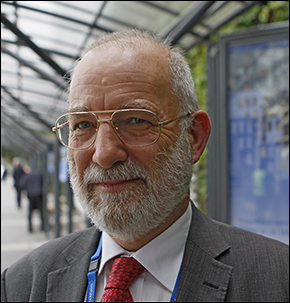


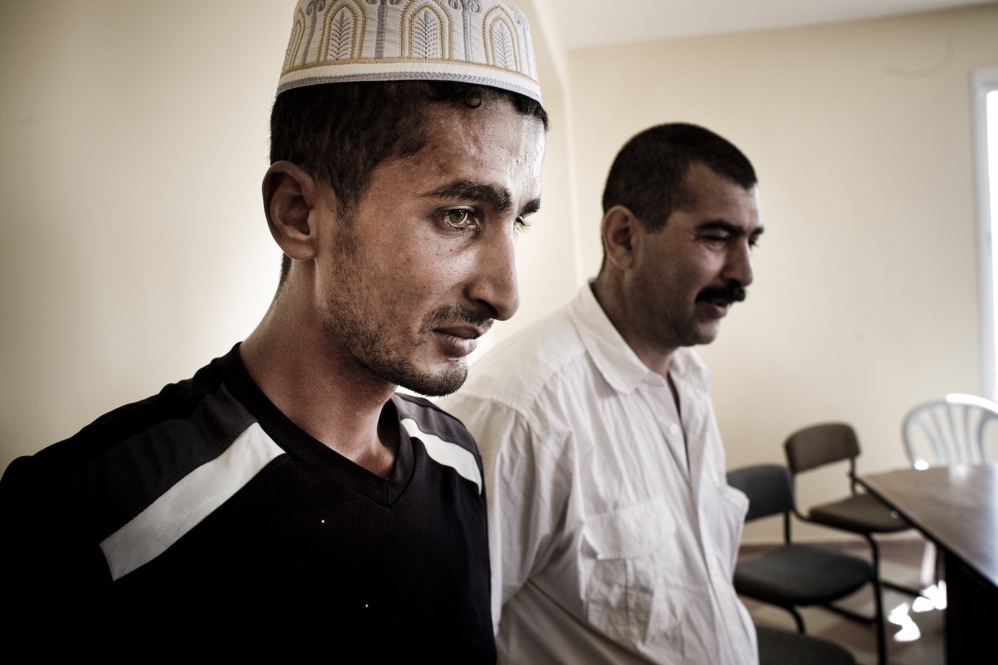


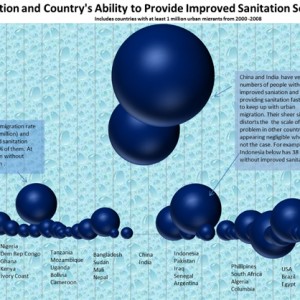
Leave a Reply
Want to join the discussion?Feel free to contribute!